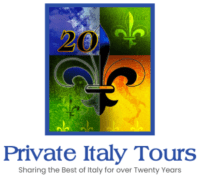Each time I drive to the sea on the SS 223, the main road connecting Siena with Grosseto, I find myself charmed and enticed by the numerous small towns that exist in what most visitors call “rural Tuscany.” This area of Tuscany is referred to as La Maremma. Once a malaria swamp, Grand Duke Ferdinando I de’ Medici (1587-1609) ordered that the marshes in this area be drained to reduce the risk of disease.
Towns like Casale di Pari, Dogana, Civita Paganico, and Civitella Marittima evoke the history of this area of Tuscany. The draw for me on this particular day is the Chiesa (Church) of San Michele Archangel and a series of frescoes created by a little known artist of the early Renaissance, Biagio di Goro Ghezzi (b. 1325 – d. 1384 – 1389). Ghezzi’s date of death remains unconfirmed.
As with most artists of this period, little is known about his early life. He was trained in the workshops in the city of Siena. His most well known commission is the cycle of frescoes for the Church of San Michele Archangel (1368); The Story of Saint Michael, patron saint of the city of Paganico, the Annunciation and the Nativity.

Story of Saint Michael Panel
 The plain exterior of the church belies the beauty within. Ghezzi’s work covers a large part of the interior, though the primary location for these masterpieces surrounds the main altar. Behind a panel of the Madonna Enthroned with Saints by Guidoccio Cozzarelli, another Sienese painter of this same period, are three walled frescoes and a breathtaking ceiling depicting the four fathers of the church.
The plain exterior of the church belies the beauty within. Ghezzi’s work covers a large part of the interior, though the primary location for these masterpieces surrounds the main altar. Behind a panel of the Madonna Enthroned with Saints by Guidoccio Cozzarelli, another Sienese painter of this same period, are three walled frescoes and a breathtaking ceiling depicting the four fathers of the church.
Frescoes by Ghezzi, Lorenzetii, and many others were created at a time when artists were just beginning to feel the freedom of painting human beings realistically, not portraying them as directed by the church. Paintings from this era show more physicality in everything from facial features to body posture, the drape of clothing to the depiction of the Christ child as a baby rather than a child’s body with a man’s head.
The cycle of frescoes in the church is stunning. From the depictions of St Michael Archangel to the moving simplicity of the Annunciation, there is a tender depth to Ghezzi’s interpretations of everything from angels to the fabric worn by the saints. Stopping in to view these masterpieces of art takes about two hours – and every minute is well worth the effort.
If your schedule permits, you can enjoy lunch at the lovely, intimate Casa Ristorante da Cinzia, Civitella Paganico located southwest of the village center. There are directional signs as you leave (or are approaching) the village. The address is Località Usi, 5, 58045 Paganico GR, Italy. Go. Worth it!
One of other the true joys of exploring Italy, especially the glorious hills and small villages south of Siena, is the possibility of enjoying very affordable accommodations along the way.
 The I Roggeti – Tenuta di Paganico, located on the Via della Stazione, 10, 58045 Stazione di Civitella Paganico GR, Italy•+39 334 629 6798 is one such place. Lovely, simple rooms, fabulous food and a great location add up to a wonderful spot from which to explore this area of Tuscany. With sites like the Abbazia of Monte Oliveto (one of the most beautifully sited and constructed Abbeys of the Benetictine Order in Italy), the towns of Grosseto and Orbetello, the beauty of the peninsula of Porto Ercole, all within an hour’s drive, there are plenty of sites to enjoy without long drives across the countryside.
The I Roggeti – Tenuta di Paganico, located on the Via della Stazione, 10, 58045 Stazione di Civitella Paganico GR, Italy•+39 334 629 6798 is one such place. Lovely, simple rooms, fabulous food and a great location add up to a wonderful spot from which to explore this area of Tuscany. With sites like the Abbazia of Monte Oliveto (one of the most beautifully sited and constructed Abbeys of the Benetictine Order in Italy), the towns of Grosseto and Orbetello, the beauty of the peninsula of Porto Ercole, all within an hour’s drive, there are plenty of sites to enjoy without long drives across the countryside.
Enjoy!



